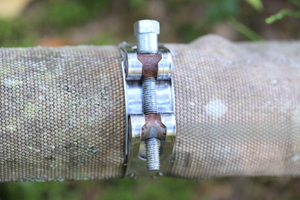Selecting the right stainless steel bends for automotive exhaust systems is critical to ensuring durability, performance, and compliance with industry standards. This guide will help you navigate key factors such as material properties, environmental conditions, and manufacturing requirements to make an informed decision.
Grades of Stainless Steel
Stainless steel bends for exhaust systems must withstand high temperatures, corrosive gases, and thermal cycling. The most common grades include:
Austenitic Stainless Steels (304, 316, 309):
Grade 304 (18/8 stainless steel) offers good corrosion resistance and affordability, making it suitable for general exhaust components.
Grade 316 contains molybdenum, enhancing resistance to chlorides and acidic environments (e.g., coastal or salted-road conditions).
Grade 309 is designed for high-temperature applications (up to 1,038°C) but may require coatings to mitigate oxidation in fluctuating thermal cycles.
Ferritic Stainless Steels (409, 441):
Grade 441 is widely used in automotive exhaust systems due to its excellent heat resistance, weldability, and cost-effectiveness. It resists oxidation and stress corrosion cracking, making it ideal for catalytic converters and mufflers.
Key Takeaway: For high-temperature zones (e.g., near the engine), consider 309 or 441 stainless steel. For corrosive environments, prioritize 316 or 304. In our factory, we mainly provide the SS304 or SS316 stainless steel bends and other material options like carbon steel, aluminized steel and SS201.
Common Bend Angles
Stainless steel bends are available in various angles to accommodate spatial constraints, airflow dynamics, and system layout requirements.
Ideal for gradual directional changes in compact systems (e.g., tight engine compartments).
Reduces turbulence and back pressure compared to sharper angles.
Commonly used in mid-pipe sections or connectors between catalytic converters and mufflers.
Widely used for sharp directional changes (e.g., connecting the downpipe to the main exhaust line). Available in short-radius (R=1.0D) and long-radius (R=1.5D) configurations.
Short-radius bends save space but increase flow resistance; long-radius bends minimize pressure drop.
Used in recirculation systems or complex layouts requiring full flow reversal.
Often paired with flex joints to absorb vibrations and thermal expansion.
Industry Standards for Stainless Steel Bends
Stainless steel bends must adhere to specific standards to guarantee dimensional accuracy, material quality, and compatibility with automotive systems. Key standards include:
GB/T 12459-2005: Specifies requirements for seamless steel butt-welding pipe fittings, including bend dimensions and tolerances for DN15–DN600 pipes. This standard is widely used for seamless 90° bends with a 1.5D bending radius.
GB/T 13401-2005: Covers steel plate butt-welding pipe fittings, applicable for larger diameters (DN150–DN1200). It ensures uniformity in wall thickness and surface finish.
ASME B16.9: An international standard for factory-made wrought steel butt-welding fittings, commonly adopted for high-pressure automotive systems.
DIN 2605/JIS B2311: European and Japanese standards focusing on bend angles (45°, 90°, 180°) and pressure ratings.
Key Takeaway: Always verify that bends meet standards like ASTM or ISO and match the exhaust system’s operational pressure and temperature ranges.
Evaluate Environmental and Operational Demands
Temperature Fluctuations:
Exhaust systems experience rapid heating and cooling. Austenitic steels like 304/316 perform well under steady heat, but cyclic temperatures above 980°C may require coatings (e.g., MgO/ZrO₂) to prevent oxidation and cracking.
Corrosion Resistance:
In coastal or high-humidity regions, chloride-induced pitting can degrade bends. Grade 316’s molybdenum content or duplex stainless steels (e.g., 2205) offer superior resistance.
Chemical Exposure:
Exhaust gases contain sulfur compounds and acids. Ferritic grades like 441 and austenitic grades with protective coatings are recommended.
Prioritize Manufacturing and Fabrication Requirements
Formability:
Austenitic steels (304/316) are easier to bend and weld, reducing production costs. Ferritic steels (441) require precise control to avoid brittleness during forming.
Surface Finish:
There are different options for you to choose, mirror polished, matte polished, brushed, sand blasting, acid pickling and etc., both internal and external. Depend on customers’ requirements.
Welding Compatibility:
Avoid galvanized steel bends due to toxic fumes and post-weld corrosion. Stainless steel grades like 441 and 304 allow safer, more reliable welds.
Cost vs. Performance Balance
Budget-Friendly Options:
Grade 409 (ferritic) is economical for non-critical components but lacks the longevity of 441 or 304.
Long-Term Investment:
Higher-grade steels (316, 441) reduce maintenance costs in harsh environments. For example, 441’s resistance to thermal fatigue extends the exhaust system’s lifespan.
Conclusion
Choosing stainless steel bends for auto exhaust systems demands alignment with standards (GB/T, ASME, ISO, etc.), material, bending radius requirements (1.5D vs. 1.0D), and manufacturing rigor. As well as the right bend angle—whether 45°, 90°, or 180°—depends on your exhaust system’s spatial layout, thermal conditions, and performance goals.
Optimize your exhaust system today—contact us for premium stainless steel bends engineered for durability and efficiency!











